Link
It’s the beginning of 2018, and one of the big questions for the year ahead is who will ultimately win our: journalists and the media or Donald Trump?
#fake news#journalism#republican#democrat#gop#resist#liberal#conservative#donald trump#dumptrump#mainstream media#trump#breaking news
2 notes
·
View notes
Photo



Happy Thanksgiving! Yesterday, Carolyn and I took a trip to Zion National Park in Utah, enjoying a relaxing hike and scenic drive. The whole Park is alien and beautiful, and looks like you’ve been transported to the surface of Mars.
#landscape photography#photography#nikon photography#original photographers#original photography#photographers on tumblr#hdrphotography#wide angle lens#zionnationalpark#hiking#outdoor#nature
1 note
·
View note
Photo

The Galleria shopping mall in Houston, Texas. Don’t know how many hours I spent on that ice skating rink growing up.
#houston#texas#shopping mall#galleriahouston#building shotz#city photography#cityscape#city style#nikon photography#hdrphotography#hdr#original photography#original photographers#photography on tumblr
2 notes
·
View notes
Photo

The DC Wharf
#original photography#original photographers#photography on tumblr#washington dc#dcphotographer#sunset#boats#harbor
1 note
·
View note
Video
youtube
Finally got around to editing some video from a few weeks ago.
A friend and former roommate of mine was recently visiting DC from Detroit, and we decided to meet up at Ivy & Coney in Shaw--an old favorite. While there, we rekindled an old and bizarre tradition, where special occasions are punctuated by a shot of Jeppson's Malort.
This obscure Swedish liqueur tastes like a combination of grapefruit juice and diesel gasoline, and could probably be used to strip paint. Its been with me in good times and in bad, through birthdays, reunions, celebrations, and game days, always serving to abruptly remind me that I have fragile nerve endings.
I'm not sure exactly where this tradition came from, but it inexplicably endures.
#jepsens malort#malort#Washington#washington dc#original video#video on tumblr#igdc#dcfocused#shaw howard
2 notes
·
View notes
Video
youtube
Yesterday was absolutely gorgeous, so Carolyn and I decided to take a bike share around the city. We traveled from DuPont Circle through Rock Creek Park to the Georgetown Waterfront, then from there to the Mall, the Wharf, and finally the Southeast Waterfront. I only crashed the bike once.
1 note
·
View note
Photo
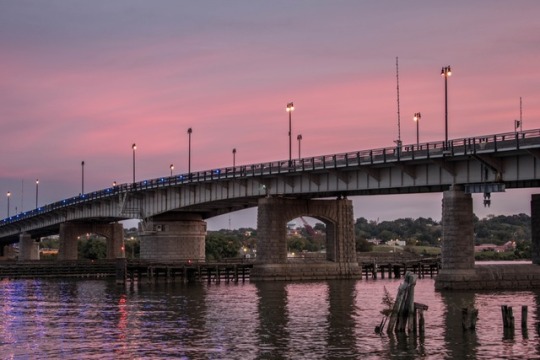
Sunset at Bardo Brewery. Carolyn and I took a long bike ride around the city, ending up here.
#sunset#photography#original photography#original photographers#photography on tumblr#hdr#color#nikon#igdc#washington dc
2 notes
·
View notes
Photo

Train station.
#city photography#photography#nikon#black and white#monochrome#original photography#photography on tumblr#street photography
5 notes
·
View notes
Photo
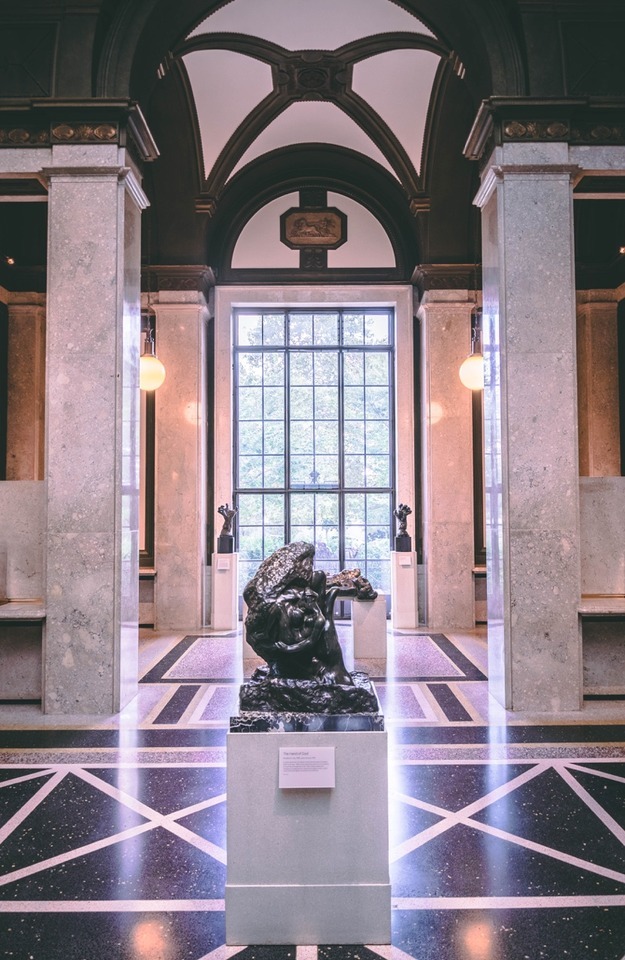
Rodin Museum in Philadelphia.
1 note
·
View note
Photo

Philadelphia freedom, shine on me.
#Philadelphia#original photographers#original photography#photography on tumblr#cityscape#nikon photography
3 notes
·
View notes
Photo

La Colombe Coffeehouse in Philadelphia.
#coffee#coffeegram#coffeehouse#photography#black and white#monochrome#photography on tumblr#original photographers#Philadelphia
2 notes
·
View notes
Photo

"Millions of peaches, peaches for me." -POTUSA
#original photography#original photographers#photography on tumblr#street photography#nikon#farmers market
1 note
·
View note
Text
The DACA Debacle

On Tuesday morning, the White House announced that it was rescinding the Obama-era DACA policy, or Deferred Action for Childhood Arrivals. This executive order shields roughly 800,000 children who were brought to the United States illegally by their parents, but who have grown up as Americans. These so-called DREAMers are a sympathetic and productive segment of our society, and the political backlash to Trump’s decision has been fierce.
Wanting to take credit for being tough-on-immigration, but not absorb criticism for attacking DREAMers, Trump has effectively punted the issue to Congress, giving them six months to find a legislative replacement for the order. This would be a major challenge in the best of times.
Immigration is an issue that always seems to be reaching a boiling point, yet somehow never gets resolved. There is a good reason for this: for most, the status quo feels acceptable and, more importantly, it serves as a perennial fundraising opportunity for both parties. Democrats tell donors they’re fighting for total amnesty, while Republicans fundraise off promises to secure the border and deport criminals. Every year, the same lines are convincingly delivered, and every year, nothing happens. As far as Washington is concerned, everybody wins.
Trump has upset this careful equilibrium, and for better or worse, is forcing Congress to finally declare its policy preferences, rather than tiptoeing around key details.
This sounds good in theory—a much-deserved kick in the pants to the DC “establishment”—but it is unfortunately occurring on the backs of very real and innocent people, who now face extraordinary fear and uncertainty. The issue must be addressed, but this is not the way to responsibly or humanely govern.
Trump has ignited a lasting political conflict, right in the same month his administration must navigate a potential government shutdown, a contentious debt ceiling vote, health insurance reauthorization, and hurricane disaster relief. The timing was clearly political, intended to rally the President’s base, but demonstrates his remarkable inexperience and shortsightedness as he throws an already fragmented Congress into further chaos.
Here is the political starting line, as of Wednesday afternoon:
Trump: The President is clearly aware of his flagging support across the broader electorate, and is determined to keep his core supporters engaged. His much-hyped border wall is unlikely to pass Congress, so he has turned his attention to unilateral options. (A note to my Democratic friends—policies that are enacted by executive order can just as easily be dismantled. The proper legislative process is harder but lasting). Targeting DACA is a political triple-threat: he can rally his anti-immigrant supporters, strike down another piece of Obama’s legacy, and force Congressional Republicans to show their cards. So long as his supporters remain the most active segment of Republican voters, Trump knows the GOP can only stray so far from his lead. To him, it seems, DACA is a solid opportunity to remind them of that fact.
Congressional Republicans: The traditional GOP is in a tight spot, as Trump is forcing them to choose between two bad options. If they enact a legislative version of DACA, they will essentially be codifying an Obama policy that many have previously opposed. Conservative voters have long been suspicious that the Party won’t follow through on tough rhetoric, and will respond viciously to a pro-DACA vote. Vulnerable Republicans can expect withered support and potential primary challenges.
Meanwhile, if the GOP fails to enact a replacement to DACA, the long-term consequences could be catastrophic, as the Party risks losing Hispanic voters for a generation or longer. While they tend to lean more towards the Democratic Party, which is far more aggressive in outreach, on the whole Hispanics have remained surprisingly untethered politically. The DACA decision could help push them over the edge, essentially delivering the key swing states of New Mexico and Nevada—and, one day, perhaps even Texas—to the Democrats. Should this happen, it will become nearly impossible to elect another Republican president.
In normal political circumstances, a president would never put his own Party in this kind of position. Once again, Trump has demonstrated that he is not really operating as a Republican, but rather an unattached force in Washington politics, pursuing his own nebulously defined agenda.
Congressional Democrats: Other than attending protests and offering obligatory attacks on Trump, Democrats have had little to do over the past 8 months. Their Party is deep in the wilderness, and spending as much time fighting itself as the Republicans. This month’s series of difficult votes, however, could give them an opening to seize initiative.
If conservative hard-liners, such as the House Freedom Caucus, demand major spending cuts in exchange for their debt ceiling votes, the Republican leadership may require Democrats to help make up the difference. They will expect concessions of their own, and DACA could be among them. Should that happen, Democrats can claim a critical legislative victory on behalf of Hispanic Americans, even as they remain in the minority.
Trump’s DACA move is the latest in a string of fly-by-wire political calculations, none of which have yielded him a victory. Just as with healthcare, Trump has charted a waffling, incoherent, middle-course on immigration; by wanting to appear both tough and compassionate, he is achieving neither.
#DACA#DefendDACA#Politics#Trump#Conservative#lLiberal#Republican#Democrat#Libertarian#Protest#immigration#immigration reform#resist
3 notes
·
View notes
Text
Police Misconduct Gets Noticed
Alex Wubbels is a nurse at University Hospital in Salt Lake City. On Friday, video surfaced of her being forcibly detained by an irate police officer after she refused to comply with an illegal order. The incident has received widespread press and social media coverage, calling renewed attention to intolerable police behavior across the country.
Wubbels was arrested for refusing to allow officer Jeff Payne to draw blood from an unconscious patient without a warrant—as long established and uncontroversial law required of her. In the full video, embedded below, we can see her being handcuffed and roughly handled in front of her horrified coworkers, then later watch her sit in a squad car as Payne patronizingly explains how she could have avoided her situation.
youtube
In the aftermath, Wubbels received a full apology from the mayor and was labeled “heroic” by the police chief. There are two important takeaways from this unpleasant episode:
First, we must demand professionalism and accountability from our police departments. They are public servants, and must be made to understand who actually employs them.
It has become fashionable among my fellow conservatives to stand behind law enforcement regardless of the circumstances; the justifications for misconduct have become almost routine, as we are reminded with overwrought deference of the difficult and dangerous job officers perform. Inevitably, we are offered the false choice of siding “with” or “against” officers.
This is garbage. The purpose of a police force is to uphold the law, not actively break it, and as Americans we do ourselves a continued disservice by lowering our standards. Most officers are hardworking, civic-minded people willing to do a tough and thankless job; their lives are made vastly more difficult when a handful of puffed-up bullies ruin their reputation and erode the public’s trust. Let’s not add to that problem by papering over the indefensible.
Real conservatives believe in limited government, particularly when it concerns the use of force and police powers. By continually sweeping aside these incidents, we are allowing law enforcement to become yet another government institution that works on its own behalf, and not for the citizens who fund it.
Second, we should ask ourselves why this particular incident has attracted so much interest. Wubbels, after all, was never seriously hurt and she received a full apology within days. Compare that to recent episodes where innocent civilians have been brutalized or killed, and the officers involved faced no serious consequences. What’s different this time?
The answer is simple and depressing: Alex Wubbels is white. It is easier for white America to presume her innocence without context, identify with her shock and fear, and be offended by her unjust treatment. Had Wubbels been a Black or Latina nurse, the public reaction likely would have been far more muted and ambivalent.
This isn’t to say white America is being intentionally racist, it’s just easier to be upset when bad things happen to people who look like us. This is at the heart of what social progressives call “systemic” or “institutional racism.” It’s not necessarily a conscious attitude, but the outcome is the same.
In recent years, a number of organizations have sprung up to call attention to this daunting social challenge—the most famous being, of course, Black Lives Matter. Set aside for a moment feelings about their politics or tactics, which are unquestionably controversial, and consider their underlying message: In this country, people of color do not receive the same treatment as their white counterparts. Their experience with police, the judicial system, and government in general is decidedly more hostile.
White America is furious when it sees police mistreatment of social peers like Alex Wubbels, but oddly silent when similar injustice is directed to Black Americans. This selective outrage must be fought; we are, all of us, entitled to equality under our laws, both in theory and in practice. This is among the most basic tenets of conservatism, but one that has fallen out of favor for the sake of political expediency. This cannot stand.
#alex wubbels#police#police misconduct#utah police#black lives matter#republican#conservative#libertarian#democrat#liberal#politics
0 notes
Text
Voyager: The Spacecraft
The twin Voyager 1 and 2 spacecraft are exploring where nothing from Earth has flown before. Continuing their more-than-40-year journey since their 1977 launches, they each are much farther away from Earth and the Sun than Pluto.
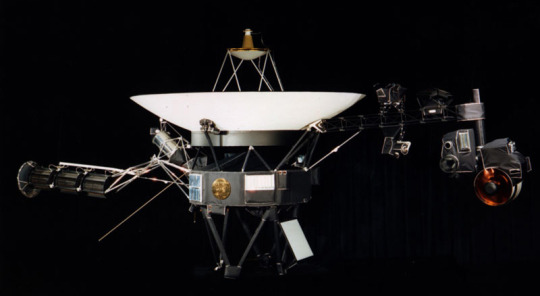
The primary mission was the exploration of Jupiter and Saturn. After making a string of discoveries there – such as active volcanoes on Jupiter’s moon Io and intricacies of Saturn’s rings – the mission was extended.
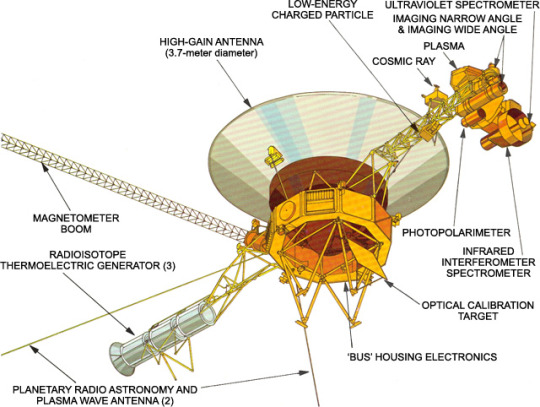
Voyager 2 went on to explore Uranus and Neptune, and is still the only spacecraft to have visited those outer planets. The adventurers’ current mission, the Voyager Interstellar Mission (VIM), will explore the outermost edge of the Sun’s domain. And beyond.
Spacecraft Instruments
‘BUS’ Housing Electronics
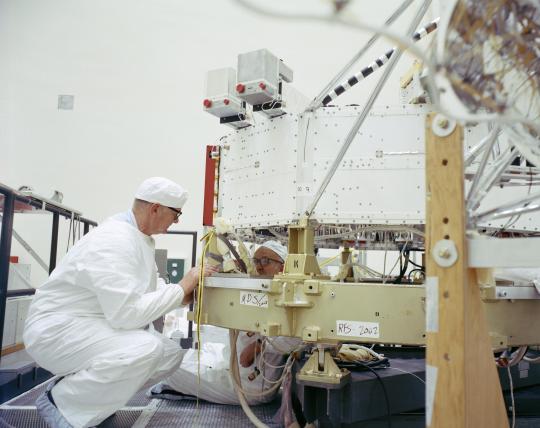
The basic structure of the spacecraft is called the “bus,” which carries the various engineering subsystems and scientific instruments. It is like a large ten-sided box. Each of the ten sides of the bus contains a compartment (a bay) that houses various electronic assemblies.
Cosmic Ray Subsystem (CRS)
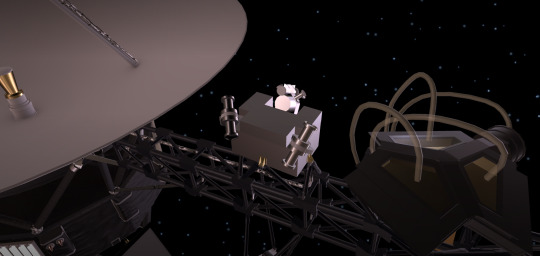
The Cosmic Ray Subsystem (CRS) looks only for very energetic particles in plasma, and has the highest sensitivity of the three particle detectors on the spacecraft. Very energetic particles can often be found in the intense radiation fields surrounding some planets (like Jupiter). Particles with the highest-known energies come from other stars. The CRS looks for both.
High-Gain Antenna (HGA)
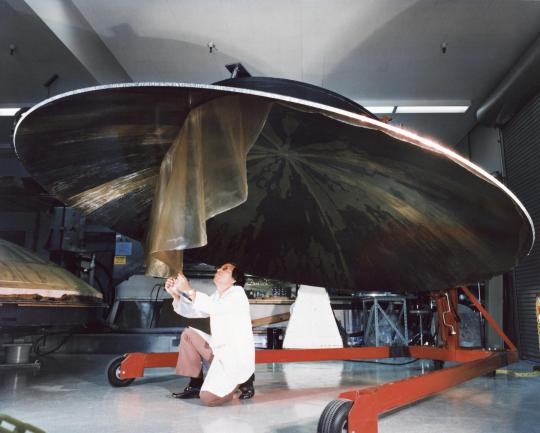
The High-Gain Antenna (HGA) transmits data to Earth on two frequency channels (the downlink). One at about 8.4 gigahertz, is the X-band channel and contains science and engineering data. For comparison, the FM radio band is centered around 100 megahertz.
Imaging Science Subsystem (ISS)
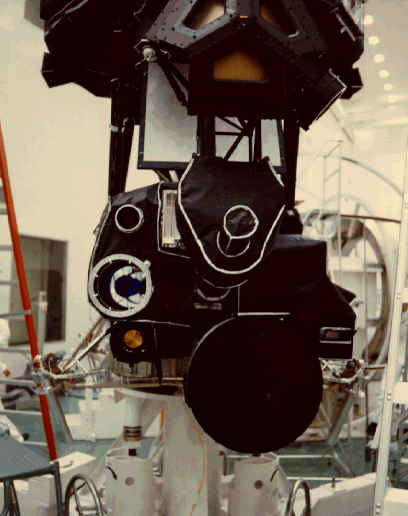
The Imaging Science Subsystem (ISS) is a modified version of the slow scan vidicon camera designed that were used in the earlier Mariner flights. The ISS consists of two television-type cameras, each with eight filters in a commandable Filter Wheel mounted in front of the vidicons. One has a low resolution 200 mm wide-angle lens, while the other uses a higher resolution 1500 mm narrow-angle lens.
Infrared Interferometer Spectrometer and Radiometer (IRIS)
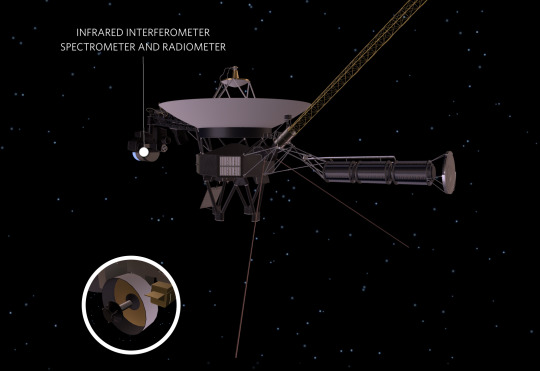
The Infrared Interferometer Spectrometer and Radiometer (IRIS) actually acts as three separate instruments. First, it is a very sophisticated thermometer. It can determine the distribution of heat energy a body is emitting, allowing scientists to determine the temperature of that body or substance.

Second, the IRIS is a device that can determine when certain types of elements or compounds are present in an atmosphere or on a surface.
Third, it uses a separate radiometer to measure the total amount of sunlight reflected by a body at ultraviolet, visible and infrared frequencies.
Low-Energy Charged Particles (LECP)
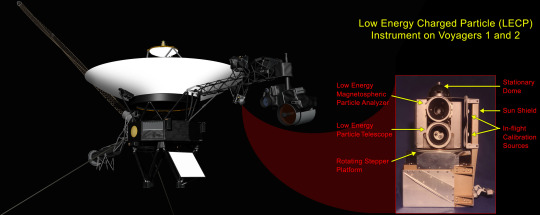
The Low-Energy Charged Particles (LECP) looks for particles of higher energy than the Plasma Science instrument, and it overlaps with the Cosmic Ray Subsystem (CRS). It has the broadest energy range of the three sets of particle sensors.

The LECP can be imagined as a piece of wood, with the particles of interest playing the role of the bullets. The faster a bullet moves, the deeper it will penetrate the wood. Thus, the depth of penetration measures the speed of the particles. The number of “bullet holes” over time indicates how many particles there are in various places in the solar wind, and at the various outer planets. The orientation of the wood indicates the direction from which the particles came.
Magnetometer (MAG)

Although the Magnetometer (MAG) can detect some of the effects of the solar wind on the outer planets and moons, its primary job is to measure changes in the Sun’s magnetic field with distance and time, to determine if each of the outer planets has a magnetic field, and how the moons and rings of the outer planets interact with those magnetic fields.
Optical Calibration Target
The target plate is a flat rectangle of known color and brightness, fixed to the spacecraft so the instruments on the movable scan platform (cameras, infrared instrument, etc.) can point to a predictable target for calibration purposes.
Photopolarimeter Subsystem (PPS)

The Photopolarimeter Subsystem (PPS) uses a 0.2 m telescope fitted with filters and polarization analyzers. The experiment is designed to determine the physical properties of particulate matter in the atmospheres of Jupiter, Saturn and the rings of Saturn by measuring the intensity and linear polarization of scattered sunlight at eight wavelengths.

The experiment also provided information on the texture and probable composition of the surfaces of the satellites of Jupiter and Saturn.
Planetary Radio Astronomy (PRA) and Plasma Wave Subsystem (PWS)
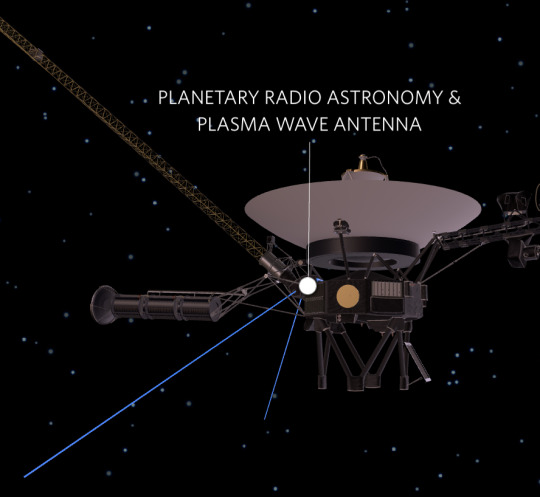
Two separate experiments, The Plasma Wave Subsystem and the Planetary Radio Astronomy experiment, share the two long antennas which stretch at right-angles to one another, forming a “V”.
Plasma Science (PLS)
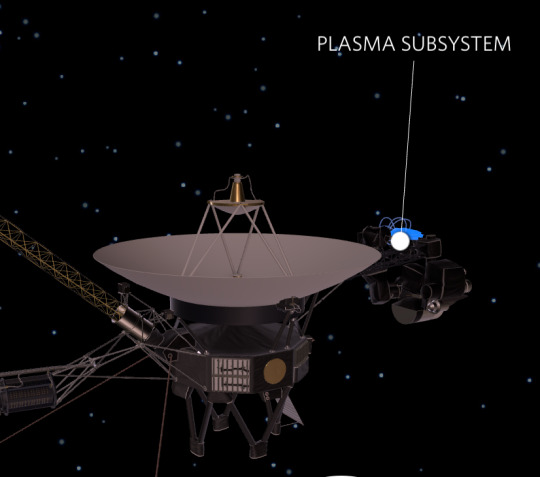
The Plasma Science (PLS) instrument looks for the lowest-energy particles in plasma. It also has the ability to look for particles moving at particular speeds and, to a limited extent, to determine the direction from which they come.
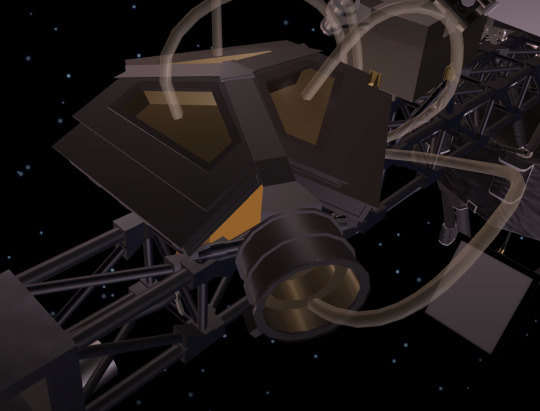
The Plasma Subsystem studies the properties of very hot ionized gases that exist in interplanetary regions. One plasma detector points in the direction of the Earth and the other points at a right angle to the first.
Radioisotope Thermoelectric Generators (RTG)

Three RTG units, electrically parallel-connected, are the central power sources for the mission module. The RTGs are mounted in tandem (end-to-end) on a deployable boom. The heat source radioisotopic fuel is Plutonium-238 in the form of the oxide Pu02. In the isotopic decay process, alpha particles are released which bombard the inner surface of the container. The energy released is converted to heat and is the source of heat to the thermoelectric converter.
Ultraviolet Spectrometer (UVS)

The Ultraviolet Spectrometer (UVS) is a very specialized type of light meter that is sensitive to ultraviolet light. It determines when certain atoms or ions are present, or when certain physical processes are going on.
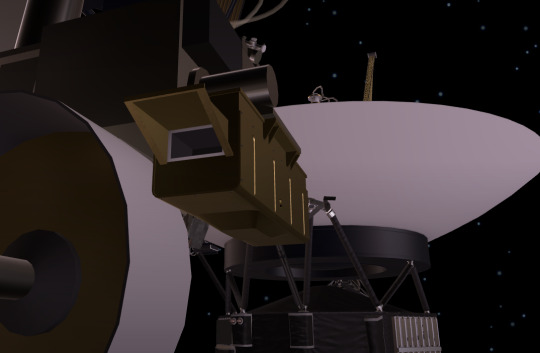
The instrument looks for specific colors of ultraviolet light that certain elements and compounds are known to emit.
Learn more about the Voyager 1 and 2 spacecraft HERE.
Make sure to follow us on Tumblr for your regular dose of space: http://nasa.tumblr.com
2K notes
·
View notes
Text
Politico Steps In It
Over the past five days, my hometown of Houston, Texas has received saturation news coverage as it battles floodwaters from Hurricane Harvey. Despite being our Nation’s fourth largest city, Houston seldom receives much media attention; for many, this week’s images will be a first impression—communities standing together in the face of indescribable loss, ordinary people opening their homes and businesses as shelters to strangers, and lines of volunteers showing up to help in whatever way possible. To most viewers, Houston’s remarkable unity and determination should be a source of inspiration, particularly in these divided times.
For some in the press, however, this positive image doesn’t sit right. After all, Texas is a red state, and they have an image of what its residents should look like: uniformly white, ignorant, and irredeemably racist. It is ground zero for the “deplorables,” home of those bad people who challenge the enlightened governance of their coastal betters. How can they be depicted as anything other than villainous, regardless of the circumstances?
Think I’m exaggerating? Check out the editorial cartoon Politico tweeted earlier this afternoon:

Drawn by cartoonist and Politico founding member Matt Wuerker, this appalling illustration received immediate and wide criticism online, and was quickly pulled. Still, it neatly encapsulates the cultural and political entrenchment of many in the press, and it isn’t pretty. In one sneering panel, Wuerker makes perfectly clear what he—and apparently, as it was published, his colleagues—thinks of “middle” America.
Note the confederate shirt, the “Secede” sign, and the Tea Party flag—this is a depiction of an ungrateful population calling for the benevolence of their paternalistic government. “Turns out you need us after all,” it scoffs to imagined caricatures. It unapologetically mocks the religious faith and intellect of a population that’s just lost everything. This is condescension that couldn’t even wait until the waters receded.
Worst of all, it’s not even accurate. Politico’s editorial board seems unaware that Houston is arguably the most diverse major city in the country. Storm surges do not discriminate, and neither, they may be surprised to learn, do the selfless men and women headed to Houston with pickup trucks and fishing boats, risking their safety to pull complete strangers from the rising water.
Are there racists and confederate sympathizers in Texas? Absolutely. Is that relevant to the hurricane and its aftermath? No. This is a media that can’t stand the idea of Texans being portrayed as anything other than hapless, undeserving victims. They have a worldview that must be maintained.
Wuerker’s timing and attitude is beneath contempt, and is perfectly indicative of an effete media that can’t understand why people don’t trust them and their preferred candidates can’t seem to win.
To be clear, I don’t believe everyone in the media shares Wuerker’s views or reptilian sense of decency. Most of the journalists I’ve known are hardworking people, deeply committed to the stories they tell. Unfortunately, people like Wuerker ruin the profession for them.
Right now, Houston is proving what it values. So too is Politico.
http://bit.ly/2gr7yh6
#Houston#harvey#hurricane harvey#conservative#republican#libertarian#media#communications & media#matt wuerker#politics#politico#journalism
0 notes
Photo

View from a naval cannon at Edinburgh castle.
#original photography#photography on tumblr#scotland#edinburgh#edinburghcastle#travel#travel photography#nikon
5 notes
·
View notes